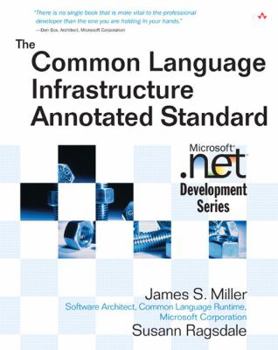The Common Language Infrastructure Annotated Standard
The Common Language Infrastructure Annotated Standard is the definitive guide to understanding the annotated specification for the Common Language Infrastructure (CLI) standard. With annotations and... This description may be from another edition of this product.
Format:Paperback
Language:English
ISBN:0321154932
ISBN13:9780321154934
Release Date:November 2003
Publisher:Addison-Wesley Professional
Length:928 Pages
Weight:3.45 lbs.
Dimensions:1.8" x 7.3" x 9.2"
Customer Reviews
5 ratings
belongs in the library of every language, library, and tool designer
Published by Thriftbooks.com User , 17 years ago
Excerpt from C# Online.NET Review (wiki.CSharp-Online.NET): "...this book goes beyond the online documentation to clarify and amplify the original standard and describe its implementation.... the single source programmers, language and tool designers, and library and VES developers need to render the CLI and the CLR fully comprehensible."
A unique 'insiders' look at many details that would otherwise not be exposed
Published by Thriftbooks.com User , 18 years ago
This is not just a reference guide (although it is a very good one). It is also (due to the annotations, often funny) that give you insight into the 'why' behind thing like naming, design decisions, things that were internally debated that we would not normally know about, and in general you come away feeling like you were there creating .NET. I find it required reading and often use it as a reference. 5 stars. An amazing read. Kind Regards, Damon Carr (...)
Excellent Reference Guide
Published by Thriftbooks.com User , 20 years ago
Well, you know it's a winner b/c it's in Addison Wesley's Microsoft .Net Development series. Like their Hejlsberg title, this is pure reference. However, there's a lot to it (almost 900 pages in total) and EVERYTHING in the CLS is covered here. It's very technical, and definitely not a cover to cover read, but there are many good examples and if you need a quick reference for any topic in the Framework, this book is a must have.
Interesting Commingling of Languages
Published by Thriftbooks.com User , 20 years ago
When Microsoft released its .NET platform, it attempted, and is attempting, something quite audacious. It is putting forth a programming environment whereby you could combine modules written in different languages, without recompiling, let alone rewriting.Arguably, Microsoft set itself a harder task than did Sun with java. Along this road, as the book describes, a standard arose - the Common Language Infrastructure. It describes a Virtual Execution System and what type of executable code can use it. So a version of Pascal, say, that wanted to run on a VES would need to pass the compilation rules of a Pascal compiler that adhered to CLI. An analogy might help. In some rough way, you might consider CLI + VES to be like a java virtual machine, and the choice of a language to use atop CLI to be like running java under its jvm. Granted, this is crude, but many readers are probably unfamiliar with CLI, whilst having more acquaintance with java.Warning. The book may be heavy sledding for most. The main audience is compiler writers and language developers. Daresay that even experienced developers may not usually deal with a language at this level. A slight irony is that CLI is meant to decouple programmers from any specific platform, which is why Microsoft pushed it over to a standards body. But the most developed instantiation currently appears to be .NET, which is inextricably interwoved with Microsoft's operating systems.
Wow! The authorative coverage of the CLI (.NET) standard
Published by Thriftbooks.com User , 20 years ago
.NET, unlike Java, is an implementation of an ECMA and a ISO standard. This book, from the Microsoft employees that created .NET and with input from members of the standards bodies, annotates the standard with comments that provide insights into the reasoning behind the standard. If you are in one of these categories, you should seriously consider buying this book: 1. advanced .NET developers2. language designers3. tool designers4. those interested in understanding virtual machines5. developers of libraries6. Java developer (wondering what a standard looks like, just kidding. As an intermediate-advanced Java developer, the book is very interesting though.)7. developer who wants insight into current software architectureOtherwise, the book is still a useful guide to help you grow as a developer if you even browse it sporadically, and unlike many programming books, it will not be obsolete in a year.




